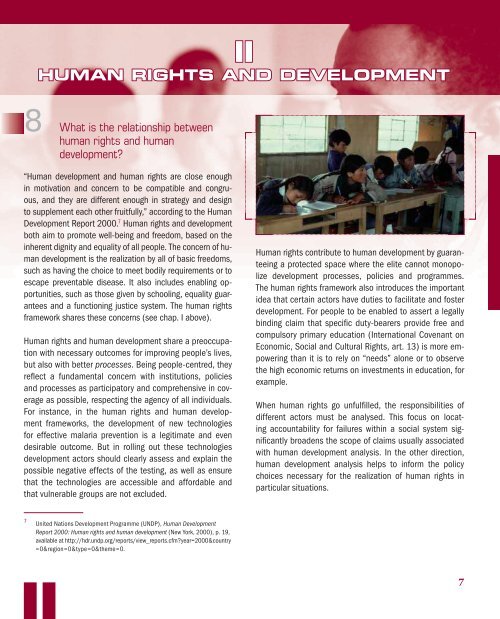IIHUMAN RIGHTS AND DEVELOPMENT8 What is the relati<strong>on</strong>ship betweenhuman rights and humandevelopment?“<strong>Human</strong> development and human rights are close enoughin motivati<strong>on</strong> and c<strong>on</strong>cern to be compatible and c<strong>on</strong>gruous,and they are different enough in strategy and designto supplement each other fruitfully,” according to the <strong>Human</strong>Development Report 2000. 7 <strong>Human</strong> rights and developmentboth aim to promote well-being and freedom, based <strong>on</strong> theinherent dignity and equality of all people. The c<strong>on</strong>cern of humandevelopment is the realizati<strong>on</strong> by all of basic freedoms,such as having the choice to meet bodily requirements or toescape preventable disease. It also includes enabling opportunities,such as those given by schooling, equality guaranteesand a functi<strong>on</strong>ing justice system. The human rightsframework shares these c<strong>on</strong>cerns (see chap. I above).<strong>Human</strong> rights and human development share a preoccupati<strong>on</strong>with necessary outcomes for improving people’s lives,but also with better processes. Being people-centred, theyrefl ect a fundamental c<strong>on</strong>cern with instituti<strong>on</strong>s, policiesand processes as participatory and comprehensive in coverageas possible, respecting the agency of all individuals.For instance, in the human rights and human developmentframeworks, the development of new technologiesfor effective malaria preventi<strong>on</strong> is a legitimate and evendesirable outcome. But in rolling out these technologiesdevelopment actors should clearly assess and explain thepossible negative effects of the testing, as well as ensurethat the technologies are accessible and affordable andthat vulnerable groups are not excluded.<strong>Human</strong> rights c<strong>on</strong>tribute to human development by guaranteeinga protected space where the elite cannot m<strong>on</strong>opolizedevelopment processes, policies and programmes.The human rights framework also introduces the importantidea that certain actors have duties to facilitate and fosterdevelopment. For people to be enabled to assert a legallybinding claim that specifi c duty-bearers provide free andcompulsory primary educati<strong>on</strong> (Internati<strong>on</strong>al Covenant <strong>on</strong>Ec<strong>on</strong>omic, Social and Cultural <strong>Rights</strong>, art. 13) is more empoweringthan it is to rely <strong>on</strong> “needs” al<strong>on</strong>e or to observethe high ec<strong>on</strong>omic returns <strong>on</strong> investments in educati<strong>on</strong>, forexample.When human rights go unfulfi lled, the resp<strong>on</strong>sibilities ofdifferent actors must be analysed. This focus <strong>on</strong> locatingaccountability for failures within a social system significantly broadens the scope of claims usually associatedwith human development analysis. In the other directi<strong>on</strong>,human development analysis helps to inform the policychoices necessary for the realizati<strong>on</strong> of human rights inparticular situati<strong>on</strong>s.7United Nati<strong>on</strong>s Development Programme (UNDP), <strong>Human</strong> DevelopmentReport 2000: <strong>Human</strong> rights and human development (New York, 2000), p. 19,available at http://hdr.undp.org/reports/view_reports.cfm?year=2000&country=0®i<strong>on</strong>=0&type=0&theme=0.7
9 What is the relati<strong>on</strong>ship betweenhuman rights, the MillenniumDeclarati<strong>on</strong> and the MillenniumDevelopment Goals?The United Nati<strong>on</strong>s Millennium Declarati<strong>on</strong> 8 explicitly placesboth human rights commitments and development goals atthe centre of the internati<strong>on</strong>al agenda for the new millennium.While Member States renewed commitments to promoteand protect human rights, they also agreed <strong>on</strong> eight quantifiedand time-bound development goals—the MillenniumDevelopment Goals. 9 These provide a focus for efforts toreduce poverty and a comm<strong>on</strong> basis for measuring progress.<strong>Human</strong> rights and the Millennium Development Goals areinterdependent and mutually reinforcing. The Goals are underpinnedby internati<strong>on</strong>al law, 10 and should be seen as part ofa broader integrated framework of internati<strong>on</strong>al human rightsentitlements and obligati<strong>on</strong>s. The Millennium DevelopmentGoals and human rights both aim to m<strong>on</strong>itor the progressiverealizati<strong>on</strong> of certain human rights. There are periodic reportingprocesses for each at both nati<strong>on</strong>al and internati<strong>on</strong>al levels,although ensuring accountability for human rights requiresa more extensive set of laws and instituti<strong>on</strong>s.The Millennium Development Goals are important milest<strong>on</strong>esfor the realizati<strong>on</strong> of the often neglected ec<strong>on</strong>omic and socialrights. <strong>Human</strong> rights help sharpen the strategies for achievingthe Goals by addressing the discriminati<strong>on</strong>, exclusi<strong>on</strong>,powerlessness and accountability failures that lie at the root8910Adopted by the United Nati<strong>on</strong>s General Assembly in its resoluti<strong>on</strong> 55/2of 8 September 2000. See http://www.un.org/millennium/declarati<strong>on</strong>/ares552e.pdf.The eight Goals are: (1) eradicate extreme poverty and hunger; (2) achieveuniversal primary educati<strong>on</strong>; (3) promote gender equality and empowerwomen; (4) reduce child mortality; (5) improve maternal health; (6) combatHIV/AIDS, malaria and other diseases; (7) ensure envir<strong>on</strong>mental sustainability;(8) achieve a global partnership for development. For a full descripti<strong>on</strong>of these Goals and corresp<strong>on</strong>ding targets and indicators, see http://unstats.un.org/unsd/mi/mi_goals.asp.See Philip Alst<strong>on</strong>, “Ships passing in the night: the current state of the humanrights and development debate seen through the lens of the MillenniumDevelopment Goals”, <strong>Human</strong><strong>Rights</strong>Quarterly, vol. 27, No. 3 (August 2005),pp. 755-829. Most, but probably not all, Millennium Development Goals canbe said to have the force of customary internati<strong>on</strong>al law.of poverty and other development problems. 11 For example,Millennium Development Goal 2 sets the target of 2015 forachieving universal primary educati<strong>on</strong>. Experience shows thatschool fees keep more girls than boys out of school, reducingthe ability to reach both Goal 2 and Goal 3 <strong>on</strong> genderequality. <strong>Human</strong> rights reinforce strategies to achieve Goal2 by establishing the right to universal, free primary educati<strong>on</strong>,and by ensuring that growth strategies are tailored tothe needs of girls and other specific marginalized groups. Theglobal Goals and targets must also be adapted to the nati<strong>on</strong>alc<strong>on</strong>text. For example, if the primary educati<strong>on</strong> enrolment ratein a country in 2004 was 95 per cent, the obligati<strong>on</strong> <strong>on</strong> theState to devote maximum available resources towards thefull realizati<strong>on</strong> of the right to educati<strong>on</strong> might—within a wideranalysis of nati<strong>on</strong>al priorities—mean that the goal of universalprimary educati<strong>on</strong> should be achieved before 2015.Other ways in which human rights strengthen efforts toachieve the Millennium Development Goals include:1112Reinforcing the legitimacy of the Goals’ implementati<strong>on</strong>strategies by building up<strong>on</strong> human rights treatyobligati<strong>on</strong>s voluntarily undertaken by Governments;Harnessing the mobilizing potential of human rightsdiscourse;Enhancing the sustainability of the strategies to meet theGoals, looking bey<strong>on</strong>d global “averages” to address theroot causes of poverty and underdevelopment, includingpatterns of discriminati<strong>on</strong> against particular groups;Building participatory and empowering strategiesup<strong>on</strong> civil and political rights; andFactoring in human rights processes and instituti<strong>on</strong>s—e.g.,courts, nati<strong>on</strong>al human rights instituti<strong>on</strong>s,informal justice systems and mechanisms at theinternati<strong>on</strong>al level (including the treaty bodies)—tostrengthen transparency and accountability for theachievement of the Millennium Development Goals. 12UNDP, <strong>Human</strong> Development Report 2003: Millennium Development Goals: Acompact am<strong>on</strong>g nati<strong>on</strong>s to end human poverty (New York, 2003), pp. 1 and30 et seq.See, for instance, United Nati<strong>on</strong>s Millennium Project Report, Investing inDevelopment: A Practical Plan to Achieve the Millennium Development Goals(2005), pp. 108 and 118-120, available at http://www.unmillenniumproject.org/reports/fullreport.htm.8
















